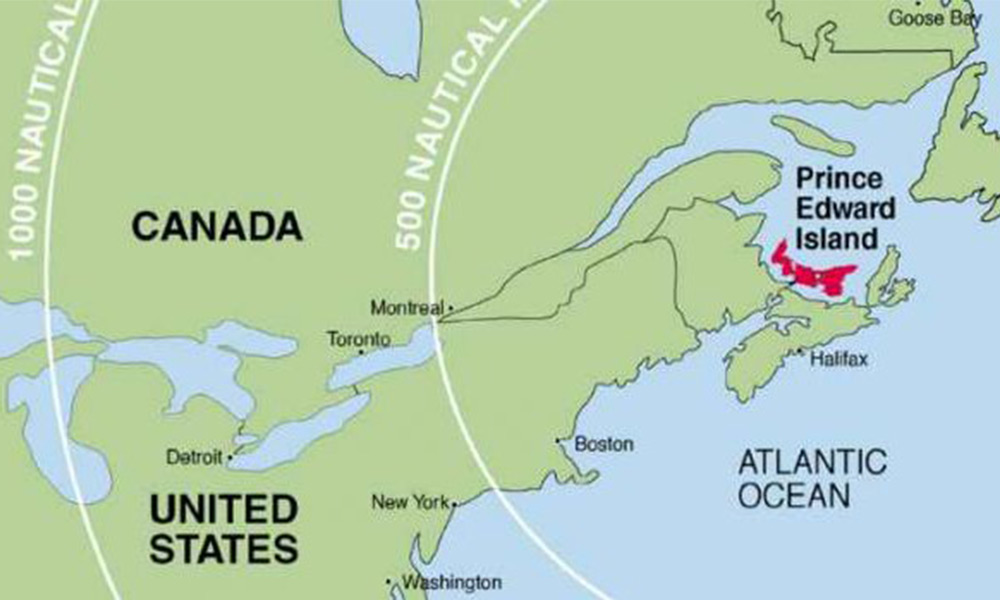About Prince Edward Island
Prince Edward Island (PEI; French: Île-du-Prince-Édouard) is one of the thirteen provinces and territories of Canada. It is the smallest province in terms of land area and population, but the most densely populated. The island has several nicknames: “Garden of the Gulf”, “Birthplace of Confederation” and “Cradle of Confederation”. Its capital and largest city is Charlottetown. It is one of the three Maritime provinces and one of the four Atlantic provinces.
Prince Edward Island is located in the Gulf of St. Lawrence, about 200 kilometres (120 miles) north of Halifax and 600 kilometres (370 miles) east of Quebec City, and has a land area of 5,686.03 km2 (2,195.39 sq mi). The main island is 5,620 km2 (2,170 sq mi) in size. It is the 104th-largest island in the world and Canada’s 23rd-largest island.
Prince Edward Island hosted the Charlottetown Conference in 1864 to discuss a union of the Maritime provinces; however, the conference became the first in a series of meetings which led to Canadian Confederation in 1867. Prince Edward Island joined as Canada’s seventh province in 1873.
According to Statistics Canada, the province of Prince Edward Island had 158,717 residents in 2019. The backbone of the island economy is farming; it produces 25% of Canada’s potatoes. Other important industries include the fisheries, tourism, aerospace, bio-science, IT, and renewable energy. As Prince Edward Island is one of Canada’s older settlements, its population still reflects some of the earliest settlers, with Canadien, Scottish, Irish, and English surnames being dominant.
Where is Prince Edward Island?

Prince Edward Island is located off the eastern coast of Canada and belongs to a group of provinces known as the Maritimes (that is Prince Edward Island, New Brunswick, and Nova Scotia). It is also considered part of Atlantic Canada, which includes the three Maritime provinces listed above as well as Newfoundland and Labrador.
At 280 kilometres long, Prince Edward Island (PEI) is Canada’s smallest province. The Island is connected to the mainland by the 12.9 kilometre Confederation Bridge, which begins in Bordon-Carleton, PEI and ends in Cape Jourimain, New Brunswick.
Prince Edward Island is in the Atlantic Time Zone, which is -4UTC hours. When it is noon in PEI, it is midnight (next day) in Beijing; 8:00 a.m. in Vancouver; and 11:00 a.m. in Toronto, Montreal, Boston and New York.
Island Geography
The geography of Prince Edward Island reflects the province’s overall uniqueness with beautiful rolling hills, pristine forests and amazing beaches. The coastline is indented by numerous bays, coves, and small inlets where you can often see the red sandstone cliffs that are a hallmark of Island scenery.
The Island is 5,620 km2 (2,170 sq mi) in size, making it the 104th largest island in the world. It is 224 km long and between 6 km and 64 km wide. With over 1,100 km of shoreline, you’re never more than 15 minutes from the beach.
The highest point in the province is found on the southern coast and stands at 142 m (466 ft) above sea level.
PEI Climate and Weather
Prince Edward Island has a mild climate thanks to the warm waters of the Gulf of St. Lawrence. Being surrounded by water also means that there is usually a breeze and at times can get quite windy.
Summer
Most PEI residents will tell you that summer is their favourite season as temperatures range between 20 and 34 degrees Celsius (70 to 93 degrees Fahrenheit). It is definitely the season of perfect beach weather; we even have the warmest waters north of the Carolinas.
Autumn
Autumn temperatures range between 8 and 22 degrees Celsius (46 to 71 degrees Fahrenheit). The mornings are cooler than in summer, but the afternoons are still warm. The Island takes on a whole new beauty as the leaves change colour to breathtaking shades of orange, red, and yellow.
Winter
During the winter, PEI receives an average total yearly snowfall of 290 centimetres (114 inches). Temperatures range between -3 to -11 degrees Celsius (26 to 11 degrees Fahrenheit), but cold winds can make it feel more like it is -25 degrees Celsius (-13 degrees Fahrenheit).
Snow usually arrives in November and lasts through April. When a snowstorm hits, the Island experiences a “snow day” when schools and businesses close until the weather clears up.
Spring
By the time spring rolls around, Islanders are happy to see the snow melt as flowers begin to bloom, grass comes alive, and trees blossom. Temperatures are quite mild, ranging from 8 to 22 degrees Celsius (46 to 71 degrees Fahrenheit).
Island Nature and Fauna
No matter where you go in Prince Edward Island, nature is always close. With vast forests, a variety of wildlife, and over 1,300 different types of plants, the Island’s natural landscape is full of beautiful diversity. It is an ideal place for hiking, fishing and birdwatching.
Animals that inhabit Prince Edward Island include:
- Beavers
- Eastern Coyotes
- Minks
- Muskrats
- Raccoons
- Red Foxes
- Red Squirrels
- Striped Skunk
- Weasel
- Snowshoe hare
- Canada Goose
- Ducks
Freshwater fish species include Atlantic salmon, rainbow trout and white perch. Brook trout is the principal sport fish and can be found in virtually every stream on the Island.
There are also 333 species of birds including great blue herons, piping plovers, and bald eagles.
Provincial Flower
The provincial flower is the lady’s slipper (Cypripedium acaule). This beautiful orchid flowers in mid-to-late June, and can be found in forest, bogs, and sand dunes. The flowers are usually pink but there are also white varieties.
Provincial Tree
The provincial tree is the red oak (Quercus rubra). This majestic tree was once very common, but two centuries of forest conversion to agriculture have made them less plentiful. Over the years, they have been harvested for construction, fuel, and wood export.
Provincial Bird
The provincial bird is the Blue Jay (Cyanocitta cristata), which is commonly seen all year long.
